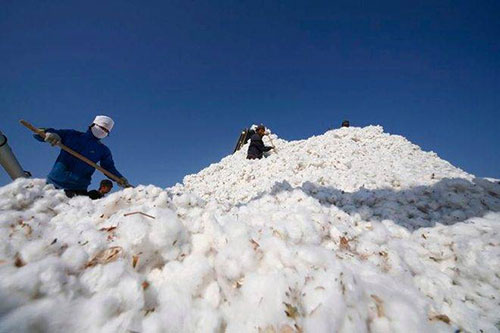FW
India’s cotton yarn exports have fallen by 38 per cent from April to September. High cotton prices in India and global trade wars have created an uncompetitive situation for Indian spinners. Indian prices are far higher than global prices. Exports of cotton yarn to markets such as China, Bangladesh, Vietnam, South Korea, Colombia and Turkey have dropped. In particular exports to the biggest market – China – have dipped 50 per cent because of reduced demand on account of the trade war with the US.
Orders from China’s weaving, knitting, and garment factories have been drying up due to the ongoing trade war with the US. This has had a cascading impact on the textile sector in Bangladesh, which has been the top destination for Indian cotton and yarn. The subdued demand has dragged prices of yarn below the cost of production in India that hit exports. Similarly, demand from Indonesia and Vietnam has also fallen for the same reason. In addition cotton yarn mills are facing declining domestic demand due to the economic slowdown. To battle the situation, some mills are reducing production by up to 30 per cent.
However, as cotton prices are set to fall with arrivals of the new crop, Indian yarn too may be back in the game from November.
Vilas V Gharat is the new president of Textile Association of India’s Mumbai unit. He has over 50 years’ experience in manufacturing functions in all composite sectors of the textile industry. He has spent more than a decade in operations and HR with an emphasis on business process consulting. He has been involved in the restructuring and transformation of large textile units. He is specialized in various fields of the textile value chain like change management, business development and project management, supply chain management, resource allocation, process reengineering and planning function. He is business consultant for Oswal Hammerle, for its upcoming state of art technology plant for manufacture of sophisticated yarn dyed shirtings. This is a joint venture project of the Oswal group and F.M. Hammerle, Austria. He has been executive director, Suvin Advisors; senior president, S Kumar’s; technical and commercial advisor, J K Cotton Mills; senior president, Morarjee Brembana.
Vikas Sharan is the new vice president. He has had a distinguished career in the textile machinery and machine tools industry. He has been with the textile machinery division of Voltas and handled the nonwovens, carpets, synthetics and circular knitting businesses of the ATE Group. He is a director of Saurer India. He is interested in sports, music, travelling and photography.
Canadian apparel giant Gildan Active Wear is moving out of Mexico, where the firm employs about 1,700 employees. It will transfer equipment to its cheaper, existing production hubs in Central America and the Caribbean. At the same time, it’s building many production complexes in Bangladesh to serve European and Chinese customers. The company is looking at its future cost structure, and believes they can achieve a much lower cost by limiting the facilities.
The will hit Mexico adversely, which has experienced its complex status as a manufacturer eroded by a range of threats from President Trump, who renegotiated NAFTA with a deal that’s yet to be ratified by Congress. However, Mexico has made an effort to target more sophisticated operations in recent years, becoming a major spot for the auto industry and attracting some aviation investment.
Montreal-based Gildan has built a global production chain ranging from yarn-spinning to clothes-stitching that has allowed the company to lower costs and compete with Hanesbrands Inc. and Berkshire Hathaway Inc.’s Fruit of the Loom. It’s heavily invested in Honduras, while its two Mexican facilities came with its 2016 acquisition of Alstyle, a company that, like Gildan, sold T-shirts and fleece to screen printers that customize them for clients. Mexico accounts for 8 to 9 per cent of Gildan’s global production.
Huntsman Textile Effects has introduced a dyeing auxiliary called Eriopon E3-Save. This is a new single-bath scour-dye-reduction clear concept providing the shortest possible processing cycle for polyester thus saving time, water, energy and cost. The dyeing auxiliary is engineered to help mills achieve considerable savings in water, energy and time for the intensive process of dyeing polyester and its blends by combining pre-scouring, dyeing and reduction clearing in a single bath. Eriopon delivers in all critical stages of polyester dyeing from pre-scouring to washing-off for exceptional performance and environmental and economic sustainability. Its environmental credentials offer mills greater processing flexibility and an optimum price-performance ratio. With cutting-edge polymer technology at its heart, Eriopon can be used to successfully dye in jet applications without the need for anti-foaming products. The superior leveling of Eriopon auxiliary also increases reproducibility, allowing mills to dispense with additional leveling agents.
Huntsman is committed to an environmentally and economically sustainable textile value chain through its range of high-performance products. The demand for polyester and manmade fibers is booming as sports and athleisure apparel markets expand rapidly around the world. At the same time, brands, consumers and mills are increasingly focused on sustainability and performance resulting in raising demand for optimization of the costly, time consuming and resource intensive polyester dyeing process.
Readymade garment exporters are working on modalities to set up a portal for exporters which will list their products category-wise on the lines of e-commerce to facilitate buyers. This mechanism will make it easy for the buyers to reach out to potential exporters.
When an importer searches for a particular product, the software will send mailers/alerts to all exporters who produce such items and also to the importer. This will increase buyer-seller interface and help both importers and exporters. The portal will be a boon for Punjab and Haryana as these two states house over 200 readymade garment exporters having base of around 2 million workers.
Readymade garments exports increased by merely 2.2 per cent to $7.8 billion during the April-September period. This was mainly due to the fact that Indian textiles were not competitive enough and around 10 per cent costlier than other countries. Also, Indian exporters face higher trade barriers as compared to countries like Bangladesh, Vietnam and Pakistan in the US and the European Union (EU). The average tariffs levied on Indian textile exports are around 6 per cent in the EU and 6.2 per cent in the US as compared to zero per cent and 3.9 per cent, respectively, on the exports from Bangladesh.
"One reason for sports licensing and merchandising not picking up in India is its low distribution capacity. Biggest Indian retailers have only around 350 to 400 stores across the country. On the other hand, Walmart and Target have 3,000 stores. This gives fans in Tier II and III towns more opportunities to access their products."
 In August, three months after Liverpool were crowned the champions of Europe, the club struck a deal with the Mumbai-based brand management and licensing agency Dream Theatre, to operate its licensing business in India and South Asia. The agency will partner with licensees to give Liverpool fans access to a range of products such as apparel, sporting goods, gifts and novelties.
In August, three months after Liverpool were crowned the champions of Europe, the club struck a deal with the Mumbai-based brand management and licensing agency Dream Theatre, to operate its licensing business in India and South Asia. The agency will partner with licensees to give Liverpool fans access to a range of products such as apparel, sporting goods, gifts and novelties.
This licensing model for international sports teams is not new to India. However, the market for sports merchandise in India is limited which made it extremely difficult for Liverpool to sell their products in the country. As the 2018 annual global industry survey of Licensing International revealed, India sold only $41 million worth of sports goods in 2018 out of the total retail sales of licensed merchandise in the country. This is less than 2.6 percent. Indian sports licensors earned just $2.4 million in royalties last year, out of a total $86.6 million royalties earned that’s less than 2.8 percent.
Low distribution, high prices boosts counterfeits
One reason for sports licensing and merchandising not picking up in India is its low distribution capacity. Biggest Indian retailers have only around 350 to 400 stores across the country. On the other hand, Walmart and Target have 3,000 stores. This gives fans in Tier II and III towns more opportunities to access their products.
Price point is also a big obstacle. Official jerseys of football clubs such as Liverpool, Arsenal and Barcelona cost between Rs 4,695 and Rs 5,499. In India, very few consumers can buy merchandise priced over Rs 2,000. This has contributed to the booming of knockoffs industry in India. These knockoffs have plagued Indian retail for decades, with the country placed fifth in list of trading fake goods. As per Organisation for Economic Co-operation and Development (OECD)’s 2018 report, counterfeit products industry is reportedly estimated to be worth $500 billion globally. In India, it is reportedly worth over Rs 40,000 crore in the organised sector alone.
Smart merchandising to build a fan culture
Besides jerseys of Indian sports teams, franchises have also started selling other merchandise such as caps, mugs, mobile phone covers, badges, and headphones, which are a lot cheaper. However, apart from teams in cricket, football and kabaddi, sports merchandising has not caught on in India. One of the major reasons for this is that Indian sports leagues are still young and haven’t created as much fan following as their Western counterparts. IPL, the oldest league, has completed only 12 seasons, while American leagues like the National Basketball Association and Major League Baseball are between 70 to over 100 years old.
Building a fan culture in India is a slow process. Abhishek Ganguly, Managing Director, Puma India advises Indian sports teams to persist with merchandising for it to become a cult. He believes international sports brands need to be smart about their merchandise business if they wish to thrive in India. He cites the example of NBA, which in its early days in India, only sold imported team jerseys. However, eventually, the association started offering a wider and more affordable range of products by tying up with Indian partners.
Like NBA, Puma has also licensed most of its merchandise in the motorsport range with brands such as Scuderia Ferrari, Red Bull Racing, Porsche Design and BMW. The range, retailed at Rs 1,299 for caps and Rs 9,999 for a jacket, is doing quite well. Growing popularity of streetwear or athleisure in India, coupled with the aspirational value of the range itself, has benefitted brand’s licensed merchandise in the country.
Licensing agency Dream Theatre also wants to tap into the sports licensed apparel category. However, for this the agency needs to introduce innovative ideas that will help it to thrive in this market.
"The market expects China to purchase foreign cotton. If procurement indeed takes place, prices of US cotton price will gradually rise. This will make it difficult for Vietnamese cotton yarn traders to reduce prices. Vietnamese yarn mills are already running in losses, and exports to China have no price advantage."
 Within the next two years, China will purchase agricultural goods worth $400-500 billion from the US. This has led to a wide speculation of whether China will now buy cotton from the US. If this happens, it will impact international cotton yarn trade by strengthening the price trend of international cotton and cotton yarn. Prices of domestic and foreign cotton will remain low which will make it difficult for the US to export cotton yarn to China. This will further pressurise Chinese traders by shrinking their trade.
Within the next two years, China will purchase agricultural goods worth $400-500 billion from the US. This has led to a wide speculation of whether China will now buy cotton from the US. If this happens, it will impact international cotton yarn trade by strengthening the price trend of international cotton and cotton yarn. Prices of domestic and foreign cotton will remain low which will make it difficult for the US to export cotton yarn to China. This will further pressurise Chinese traders by shrinking their trade.
This loss will compel cotton yarn import traders to exert pressure on forward market, increasing the burden on yarn exporting countries of the world. At present, no other country, except China, can accommodate the surplus cotton yarn produced by countries like Vietnam, India, Pakistan, Uzbekistan, etc. As a result, these countries can only export cotton yarn to China.
Rise in US cotton prices to impact Vietnam traders
The market expects China to purchase foreign cotton. If procurement indeed takes place, prices of US cotton price will gradually rise. This will make it difficult for Vietnamese cotton yarn traders to reduce prices. Vietnamese yarn mills are already running in losses, and exports to China have no price advantage. The spinners can only undersell stocks or sell at losses to Chinese traders when they cannot find substitute markets. If China purchases US cotton, its import of cotton yarn may shrink but the shrinkage will be not be large, mainly supported by various factors.
As no other market except China can accommodate the cotton surplus of countries like Vietnam, they are forced to sell at low prices. This increases their cycle of losses. For Vietnamese yarn, as prices of US cotton are more than that of Brazil and West African cotton, the amount of US cotton being purchased by Vietnam is likely to decrease. In addition, poor export of cotton yarn may accelerate the development of downstream textile market in Southeast Asia and increase local consumption of cotton yarn.
Chinese purchases of US Cotton to benefit global market
If the Sino-US negotiations develop well, China will procure massive amounts of US cotton which will drive global cotton price. Chinese traders will also benefit from the time difference between Jan and Mar in international cotton trade. The advantages of processing costs will also benefit them and the country’s outward investment flow in cotton yarn will increase.
The purchase of US cotton by China will thus have a certain impact on imported yarn market. However, if this procurement is carried out methodically, imported yarn traders and foreign mills will be able to bear greater pressure. Though import of cotton yarn may shrink, losses would still be manageable.
"Birla Modal is a premium specialty fiber that offers superior softness. It’s a nature-based fiber made from wood sourced from Canadian Birchwood trees. The Modal has twin benefits: superior softness + strength akin to cotton. So, even after repeated washes, fabrics made from this fiber retain their softness without losing its perfectly brilliant sheen, colors as well as soft hand feel."
 From past many years Global cellulosic fiber market is witnessing immense growth especially viscose which has shown growth up to 6 per cent to 7 per cent. The essential factors considering the above growth are raising prosperity, rapid urbanisation, expansion in the middle class and higher disposable income along with dynamic consumer preference for easy and comfortable, fashionable & biodegradable products.
From past many years Global cellulosic fiber market is witnessing immense growth especially viscose which has shown growth up to 6 per cent to 7 per cent. The essential factors considering the above growth are raising prosperity, rapid urbanisation, expansion in the middle class and higher disposable income along with dynamic consumer preference for easy and comfortable, fashionable & biodegradable products.
Forecasting the coming year's Global demand for viscose fiber is estimated to grow faster at 7-8 per cent, while specialty fibers like modal/micromodal, dyed, excel (Lyocell) expected to grow even faster. To leverage this growing demand for cellulose fibers, Liva-the new age fabric brand from the Aditya Birla Group has launched Birla Modal-a second generation of man-made cellulosic fibers which couple great consumer and value chain benefits. Liva is a soft fluid fabric which falls and drapes well. The fabric promises its delivery through accredited value chain.
Birla Modal is a premium specialty fiber that offers superior softness. It’s a nature-based fiber made from wood sourced from Canadian Birchwood trees. The Modal has twin benefits: superior softness + strength akin to cotton. So, even after repeated washes, fabrics made from this fiber retain their softness without losing its perfectly brilliant sheen, colors as well as soft hand feel. It can be the right blending fiber partner when made with different fibers. The benefit of Birla Modal can also be appreciated when blended with cotton ensuring the property benefit of both Modal & Cotton. Both being Cellulosic fibers, processing can be done with much ease.
The highlighted factors of Birla Modal are its moisture management that help efficient transport of sweat from the skin to the outside. The fibers require less quantity of dyes compared to other cellulosic fibers for Brilliant colors with better sheen. It has cooling effect as fabrics made from Birla Modal are cooler in comparison to cotton. Apparels manufactured from Birla Micro Modal are lighter, exhibits superior softness and good dimensional stability. It is skin-friendly and finds excellent applications across the different end in consumer applications. Birla Modal is also available as a finer fiber which is called Birla Micro Modal.
The National Council of Textile Organizations (NCTO), represents its full spectrum of U.S. textiles coming from fiber through finished sewn products has launched its all-new blog at www.TextilesintheNews.org.The blog will have posts on varied issues and developments in the U.S. textile industry, relating from trade policy, regulatory and legislative updates to profiles on American textile companies to features on innovations, sustainability efforts and human interest stories.
NCTO is a Washington, DC-based trade association that represents domestic textile manufacturers, including artificial and synthetic filament and fiber producers. U.S. employment in the textile supply chain was 594,147 in 2018. The value of shipments for U.S. textiles and apparel was $76.8 billion in 2018. U.S. exports of fiber, textiles, and apparel were $30.1 billion in 2018. Capital expenditures for textile and apparel production totaled $2.0 billion in 2017.
The World Trade Organisation (WTO) has ruled against at least five of India’s export promotion schemes, saying it was granting prohibited subsidies. The US had approached the multilateral body in protest against India’s grant of subsidies. However, the US claims regarding a subset of exemptions from customs duties and an exemption from excise duties were rejected by the WTO. The US had dragged India to the WTO in March 2018, questioning its export promotion schemes as the trade battle between the two countries intensified.
India has been given 90 to 180 days to withdraw concessions under the schemes, which include the Merchandise Exports from India Scheme, the Special Economic Zones scheme, the Export Oriented Units, Electronics Hardware Technology Park and Bio-Technology Park schemes, the Export Promotion Capital Goods and the Duty-Free Imports for Exporters schemes.
WTO says India grants prohibited export subsidies in the form of exemptions from customs duties, deductions from taxable income, and the issuance of notes or scrips that firms can use to pay off certain debts. India is said to provide prohibited subsidies to Indian exporters worth more than $7 billion annually to producers of steel products, pharmaceuticals, chemicals, information technology products, textiles, and apparel, to the detriment of American workers and manufacturers.












